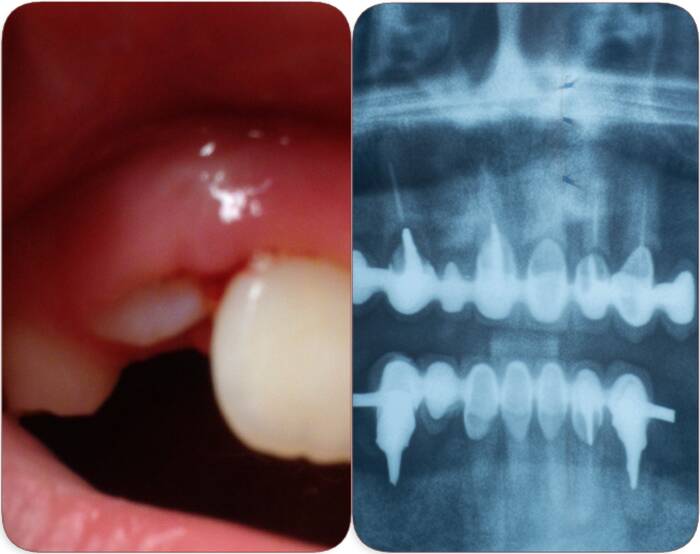What is a jaw bone coming through gum after tooth extraction? What to do when you notice this phenomenon? Is It dangerous? What can be done to achieve rapid healing after dental extraction? Which bone preservation treatment after dental extraction? And finally, how can the dental bone be reconstituted?
I. Jaw Bone Coming Through Gum After Tooth Extraction, where Does It Come from?
The bone chip is the name given to the small piece of bone that comes out of the gum following a tooth extraction.
During a dental extraction, it is not uncommon for bones to be fractured.
The bone splinter can be uncomfortable and even painful for some people.
A bone splinter is usually seen at the end of tooth extraction. If you run your tongue over the area, you can feel a small piece of bone.
This is a jawbone, not a tooth remnant as many people think.
It is not uncommon for the bone chip to disappear on its own. However, sometimes it is necessary to consult a dentist to get rid of it.
II. What to Do About a Jaw Bone Coming Through Gum After Tooth Extraction?
Although a bone chip after tooth extraction can be scary and painful, it is usually a minor problem.
Most of the time, this small piece of bone that comes out of the gum after extraction, resorbs by itself.
But if after a while the splinter is still present, then it may be necessary to consult a specialist.
In some cases, the splinter is filed down, while in others it is removed under local anesthesia.
This operation is quite trivial and does not cause any real damage.
Tooth extraction can become a health problem, especially if alveolitis occurs after the extraction.
This is an infection of the alveoli, which appears a few days after tooth extraction.
III. What Can Be Done to Achieve Rapid Healing After a Tooth Extraction?
It is difficult to determine how long it takes for a tooth extraction to heal. However, certain behaviors help the healing process.
- Avoid spitting too much, as this promotes bleeding.
- It is also not advisable to run your tongue over the area where the tooth was extracted. This will only delay the healing process.
- Do not rinse your mouth for 24 hours after the tooth extraction. This may prevent healing.
- 24 hours after the extraction, use a saltwater mouthwash. This will help the teeth heal more quickly.
- Apply a piece of gauze to the extraction area and bite down on it firmly for several minutes. This will stop the bleeding if you have any.
- Teabags or ice can also be placed on the affected area. Both will help the wound heal.
- Elevate your head. This will reduce the blood supply to the extraction and improve healing.
- Eat soft, liquid foods at room temperature that are not too hot or too cold.
IV. What Bone Preservation Treatment After a Tooth Extraction?
After tooth extraction, a few days later, there is bone resorption in the gums, both lengthwise and widthwise.
This bone loss is not only unsightly but also poses a problem if a dental implant is to be placed.
To alleviate this problem, bone preservation is done.
This consists of using a biomaterial as a bone substitute. PRF, “Platelet Rich Fibrin” can be used to promote healing or as a collagen sponge.
Bone preservation is done as follows:
- Simple surgery is done, aiming at the separation of teeth with several roots.
- Then a biomaterial, which can be a collagen sponge or PRF, is applied. This will allow for the formation of a blood clot that promotes healing.
- Finally, the surgical site is sutured.
V. Other Questions Related to Jaw Bone Coming Through Gum After Extraction
# What Mouthwash Should I Use After a Tooth Extraction?
It is recommended that you do not rinse your mouth for 24 hours after tooth extraction. The mouth should be given time to heal on its own.
Then, you can use a saltwater mouthwash.
To make this mouthwash, all you have to do is put a spoonful of salt in a glass of warm water.
Use this mouthwash twice a day. The saltwater will improve the healing of the teeth.
# How to Rebuild the Dental Bone?
The reconstitution of the dental bone can only be done with the use of biomaterials.
Some laboratories have developed synthetic bone products to allow better bone reconstitution.
They act as a framework for the bone being formed.
Thus, if a dental implant is to be made but bone regeneration is required beforehand, the biomaterial is inserted into the cavity.
To facilitate bone regeneration, the area is covered with a membrane made for this purpose.
Only after the bone has regenerated will the implant be placed.
Other studies for bone regeneration of the tooth use calcium phosphate.
Although this element cannot regenerate bone, it helps the stem cells to do so.
To achieve optimal bone regeneration, this calcium phosphate biomaterial is coupled with the patient’s stem cells.
These stem cells are derived from the patient’s hip and spinal cord.
This amalgam is applied to the edentulous area.
# How Do You Know if You Are Healing Well After a Tooth Extraction?
There is no set healing time for everyone. It usually takes 3 to 4 weeks to heal properly.
You will know that your gums are healing properly if you notice a whitish film at the extraction site after a while.
This will fall off a few days later.
Useful Links:
Jawbone remodeling: a conceptual study based on Synchrotron High-resolution Tomography
Quantitative assessment of the jawbone quality classification: A meta-analysis study
Regulatory mechanisms of the jaw bone and tooth development

